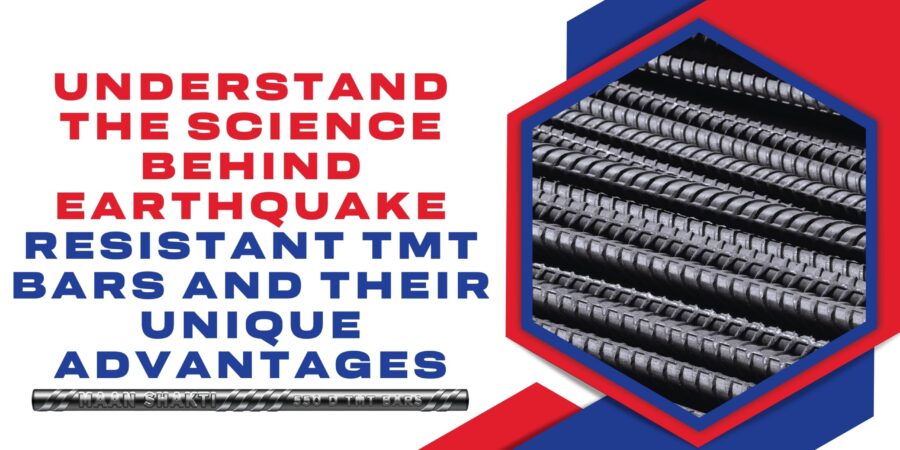Thermo-mechanically treated (TMT) bars stand at the forefront of modern construction, redefining structural strength and resilience. These bars undergo a specialized heat treatment process, fusing thermal and mechanical treatments to impart exceptional properties crucial for building integrity. TMT bars are recognized for their high tensile strength, ductility, and toughness, making them indispensable components in construction projects worldwide. Their significance extends beyond conventional reinforcement, especially in regions prone to seismic activity, where the demand for earthquake-resistant structures is paramount.
But how do these earthquake-resistant TMT bars work? Understanding the science behind is important for both builders and developers as they closely work with TMT bars.
This is why, we are here to help you out by delving into the scientific principles behind earthquake-resistant TMT bars.
Understanding the Material Science Behind TMT Bars
Let us first discuss the specific properties of TMT bars that contribute to their earthquake resistance. We tried to simplify some of these factors of the steel bars that make it a perfect product both for the buyers and TMT Bars suppliers.
Fine-Grained Ferrite-Pearlite Structure
The heart of TMT bars lies in their microstructure. The Thermo-Mechanical Treatment induces a fine-grained ferrite-pearlite structure, enhancing the bars’ mechanical properties. This microstructural refinement contributes to increased strength and ductility, crucial for earthquake resistance.
Alloying Elements
The incorporation of alloying elements, such as vanadium and niobium, further augments the earthquake-resistant qualities of TMT bars. These elements contribute to the bars’ ability to withstand dynamic forces, making them a reliable choice in seismic-prone areas.
Ductility for Controlled Deformation
Exceptional ductility is inherent in TMT bars, allowing controlled deformation without compromising strength. This property enables the bars to absorb and dissipate seismic energy efficiently, mitigating the impact of sudden shocks and vibrations.
High Yield Strength
TMT bars exhibit an impressive yield strength, a result of controlled heat treatment. This characteristic ensures that the bars maintain structural stability under severe seismic stress, preventing premature failure during dynamic loading.
Work Hardening Mechanism
Under stress, TMT bars undergo work hardening, a process where the material strengthens through plastic deformation. This mechanism further enhances the bars’ toughness, making them resilient against the cyclic loading associated with seismic events.
Advantages of Earthquake-Resistant TMT Bars in Seismic Zones
One of the foremost advantages of utilizing Thermo-Mechanically Treated (TMT) bars in seismic zones lies in their ability to enhance structural resilience. However, apart from this, there are some unique advantages that it has to offer.
Cost-Effectiveness in Construction
In seismic-prone regions, where construction demands materials capable of withstanding dynamic forces, TMT bars offer a cost-effective solution. Their superior strength allows for the use of fewer bars compared to conventional reinforcement, reducing material costs while maintaining or even improving structural performance.
Mitigation of Seismic Hazards
By incorporating TMT bars, builders and developers can actively contribute to the mitigation of seismic hazards. These bars, with their ability to absorb and dissipate seismic energy, act as a frontline defense, minimizing potential damage and ensuring the safety of occupants in seismic zones.
Long-Term Durability
TMT bars contribute to the long-term durability of structures in seismic zones. The thermo-mechanical treatment process imparts corrosion resistance, ensuring that the bars remain robust over time, even in challenging environmental conditions. This longevity translates to sustained structural integrity and reduced maintenance costs for buildings in earthquake-prone areas.
Compatibility with Modern Construction Techniques
TMT bars seamlessly integrate with modern construction techniques, including pre-fabrication and modular construction. Their compatibility enhances the efficiency of construction practices, aligning with contemporary trends while ensuring the seismic resilience of the built environment.
Takeaway
In conclusion, earthquake-resistant TMT bars emerge as indispensable allies in the realm of modern construction, providing a multifaceted solution to seismic challenges. The detailed exploration of their material science revealed a harmonious blend of a variety of qualities that makes these TMT bars a perfect fit to stand against natural disasters like earthquakes.
As builders navigate seismic zones, the adoption of TMT bars not only meets but exceeds the demands of earthquake-resistant construction. This enhances the work of TMT bars suppliers as well as they provide an essential element for a resilient and enduring structure.


